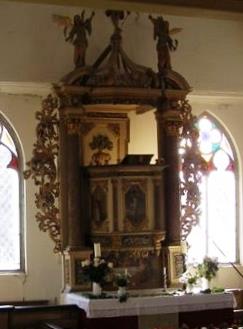The Church of Ludwigsburg in a Baroque Perspective
The village Ludwigsburg, formerly known as “Darsim” or “Dersem”, also received a chapel under the patronage of the monastery of Eldena. After Reformation and Secularization, Duke Ernst-Ludwig from Pomerania-Wolgast gave the property of the monastery of Eldena to his wife Sophia Hedwig from Braunschweig-Wolfenbüttel. During these times, the village Darsim and the little chapel changed its name to “Ludwigshoff” (this altered to the nowadays name “Ludwigsburg”) to honor her husband. In the next years the church was exclusively open for the Dukes family. A new church was constructed according to the plans of the new owner Jacob Heinrich Müller von der Lühne.

The church’s interior was constructed during the baroque period and the pulpit altar was probably built by Elias Keßler, the most famous Pomeranian sculptor. These pulpit altars were typical for the baroque period from the 17th until the 19th century. In the Reformation, sermon (the word of God) became central in Lutheran liturgy and through the symbiosis of pulpit and altar, an equal status was reached. The altar screen is composed with channeled pilasters and bar grates.

The former owner Jacob Heinrich Müller von der Lühne donated the bell and the candelabra. The portal of the churchyard has its origin in the 18th century and is structured by arched windows. During 1865, the baptismal font, the church seating and the organ loft were built up. Two years later, the organ was constructed by Barnim Grüneberg in Stettin and in 2011 the whole instrument was restored.
